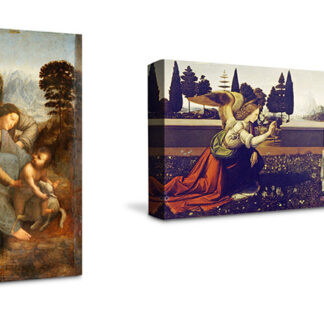-
×
 Leonardo da Vinci Bundle - 2 Stretched Canvas Giclee Prints
Leonardo da Vinci Bundle - 2 Stretched Canvas Giclee Prints
- Includes:
The Virgin and Child with Saint Anne × 1
Annunciation × 1
Subtotal: $245.00
Le Moulin de la Galette is an oil painting by Vincent van Gogh, created in 1886, which depicts the iconic windmill of the same name located in Montmartre, Paris. Van Gogh’s “Le Moulin de la Galette” features a close-up view of the windmill, which takes up most of the canvas, with only a small section of the Montmartre neighborhood visible in the background. The painting is notable for its use of thick, swirling brushstrokes and a vibrant color palette that captures the energetic atmosphere of the area.
Van Gogh was deeply influenced by the Impressionist movement, which was popular in Paris at the time, and the use of bright, contrasting colors and thick brushstrokes in “Le Moulin de la Galette” reflects this influence. The painting also demonstrates Van Gogh’s unique style, which is characterized by the use of intense, contrasting colors and the application of paint in bold, thick strokes.
The windmill depicted in the painting is a well-known landmark of Montmartre and was a popular subject for artists during the late 19th century. The Moulin de la Galette was originally built in the 17th century as a flour mill but was later converted into a dancehall and became a gathering place for artists, writers, and other bohemian types in the area. The windmill and the dancehall it housed have become synonymous with the free-spirited and artistic atmosphere of Montmartre in the late 19th century.
In conclusion, “Le Moulin de la Galette” is a beautiful and vibrant painting that captures the essence of one of Paris’s most famous landmarks. Van Gogh’s use of color and brushstroke create a sense of movement and energy, while the focus on the windmill itself creates a sense of timelessness and continuity. The painting remains a beloved work of art and a testament to Van Gogh’s unique style and vision.